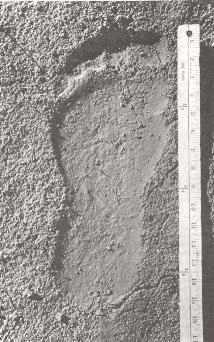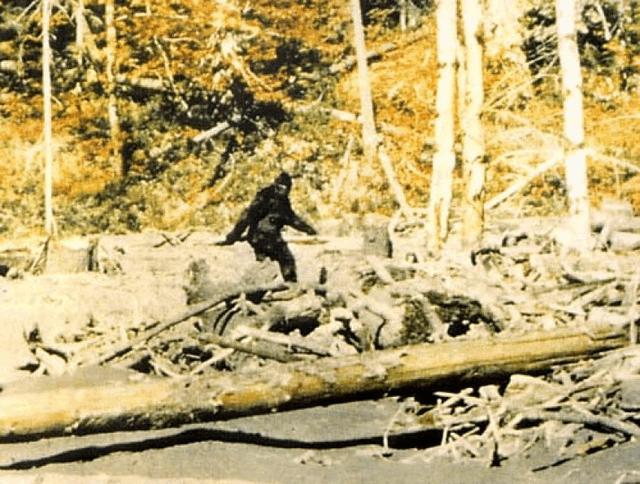|
Bluff at Bluff Creek— |
||||
|
In 1958 the Himalayas were too remote and the Sasquatch too obscure to fuel a sustainable legend. Northern California’s lumber areas, however, were remote but still accessible. The area was perfect to sustain the legend of a Yeti in America. The concept would ignite all of North America, and the resulting image of a cone headed giant is the norm today. In 1957 the Hammer film The Abominable Snowman of the Himalayas had been released and was playing over the silver screens. It was the ultimate Yeti film. It gave us towering monsters we never really saw clearly
No one knew what to make of it, but locals recalled having heard a legend of an odd creature that dwelt in the Siskiyous. A little digging into the past uncovered some detailed old west stories. The creature had been called the Kangaroo Man because of his agility. He used to terrorize folks in the nearby Sixes Rivers area in southern Oregon and northern California. The descriptions were hard to believe. He was about 7 feet tall, hairy all over, long arms, and was declared to have been a human monster. The last newspaper reports of him were about 55 years before at the turn of the century. Had he been a big Indian or some wild renegade? No one had known then, and no one now knew who was responsible for these large tracks. The continued reappearance of the big footprints, however, finally got coverage in the AP and local Humboldt Times in early October 1958. The Well, it was a great story; indeed such an intriguing story that the Humboldt Times dug up more stories. Naturally, The Kangaroo Man was one of them. (He hadn’t been reported in print since the Lane County Leader, April 7, 1904.) Of course, other stories came out, mostly more reports of footprints. Finally it was declared that if “Big Foot” was a big Indian he was hurting no one. He was merely inspecting the logging equipment. It didn’t end there. The potential behind this mysterious denizen of the forest was too intriguing. Stories of the old Kangaroo Man started to give everybody an idea just what might be “Big Foot.” It didn’t sound like a big Indian was still on the loose from 55 years before. Another old news article had been dug up. It made “Big Foot” sound far more frightening. The Myrtle Point Enterprise on March 11, 1904: The appearance of the ‘Wild Man’ of the Sixes has thrown some of the miners into a state of excitement and fear. A report says the wild man has been seen three times since the 10th of last month. The first appearance occurred on ‘Thompson Flat.’ William Ward and a young man by the name of Burlison were sitting by the fire of their cabin one night when they heard something walking around the cabin and which resembled a man walking and when it came to the corner of the cabin it took hold of the corner and gave the building a vigorous shake and kept up a frightful noise all the time— the same that has so many times warned the venturesome miners of the approach of the hairy man and caused them to flee in abject fear. Mr. Ward walked to the cabin door and could see the monster plainly as it walked away, and took a shot at it with his rifle, but the bullet went wild of its mark. The last appearance of the animal was at the Harrison cabin only a few days ago. Mr. Ward was at the Harrison cabin this time and again figures in the excitement. About five o’clock in the morning the wild man gave the door of the cabin of vigorous shaking which aroused Ward and one of the Harrison boys who took their guns and started in to do the intruder. Ward fired at the man and he answered by sending a 4 lb. rock at Ward’s head but his aim was a little too high. He then disappeared in the brush. The potential behind “Big Foot” didn’t seem gentle and harmless, did it? As more old stories were being uncovered, “Big Foot” was getting quite a pedigree. In 1904 the Kangaroo Man had been known in the area for at least 30 years. Four years earlier The Daily Review of Roseburg had already summarized accounts in a report dated December 24, 1900. The appearance of this animal is almost enough to terrorize the rugged mountaineers themselves. He is described as having the appearance of a man— a very good-looking man— is nine feet in height with low forehead, hair hanging down near his eyes, and is covered with a prolific growth of hair which nature has provided for his protection. Its hands reach almost to the ground and when its tracks were measured its feet were found to be 18 inches in length with five well formed toes. The article ended with the witnesses expressing their desire to know if what they had seen was a “devil, some strange animal, or a wild man.” New stories about Bigfoot dovetailed on these old accounts. Reports of Bigfoot “temper fits” found there way into the local press. In one incident, he took on a pack of dogs and slammed them against a tree. Bigfoot did not like dogs, that was clear, and they did not like him. An image of a strange “man animal” began to be drawn. He was a giant troglodyte that threw gas cans, earthmover wheels, even culverts. Though some of these tales made national news, a lot of that stuff was giggled at locally around Willow Creek, the center of the logging industry in those parts. Garish disproportion, but the look of the troglodyte is fascinating. From a 1965 San Francisco Chronicle article by George Draper-- “Man Animals of the Northwest.” What all this came down too was this: some big footprints, of 2 radically different kinds, had been found around the lumber roads. The most beneficial information that came out of the hoopla was the uncovering of old stories of a Kangaroo Man or the “Omah,” as the Indians called him. They were wild men that howled and whistled and were hairy all over. They had long arms and big feet. As exciting as these reports were, they nevertheless would no doubt have fizzled and remained only around the Bluff Creek area, becoming yet another addition to the old stories of the Kangaroo Man. However, when news first broke, the Vancouver Province picked up on it and ran the story “New Sasquatch Found.” Having only heard of big foot prints, it was an obvious corollary for the main British Columbia paper to make. Sasquatch was still a pretty nebulous entity for Canadian Whites in 1958. White Man’s legend had painted him as a tall, wild hairy Indian. This Province report would unintentionally set in motion a chain of events that would prove significant to derailing the true search for Sasquatch. A local Canadian journalist, John Green, read it. He had been changing from skeptic to believer for a couple of years. He was beginning to believe that Sasquatch was real but something quite different from the legend. In 1958 British Columbia was celebrating its centenary. For a couple of years before this, in preparations for the upcoming festivities, Sasquatch had become a big deal again because many wanted to use it as one of the cultural symbols for British Columbia. This brought to the fore eyewitness reports. The most recent had been in 1955. It was an encounter with something like a hairy “man ape,” a concept more in line with the world famous Yeti. Two reports in particular had impressed John Green. He was one of the first to publish the William Roe sighting, which was the October 1955 encounter on Mica Mountain in the Canadian Rockies. The other report required lots of back tracking. It was the Ruby Creek Incident of 1941. He had listened attentively to Jeannie Chapman recite what had happened on their farm in that October of 1941. From her description of the “Sasquatch,” John Green was beginning to believe. Therefore when the Province ran its article in October 1958 on “Big Foot” showing dozer Jerry Crew holding a cast of a huge flat foot, Green took an interest in Bluff Creek and traveled there to pick up firsthand information. He believed that Bigfoot could indeed be the Sasquatch. The drawing by William Roe’s daughter, Myrtle Walton, under his direction, of what he believed was a female Sasquatch. It was more ape than man, and this concept was not a part of Canadian Whites’ legend. Green had the investigative ability to dispel any connections, but he failed to do so. On one hand, he listened to the old stories of the Kangaroo Man and “Omah,” stories which suggested something like the Sasquatch. Yet on the other hand he did little to challenge the current physical evidence in the form of these funny plaster footprint casts. More than anybody, Green was in a position to expose them. He had done some admirable investigation into the Ruby Creek incident. He had discovered that in 1941 a Washington State sheriff, Joe Dunn, had come to Ruby Creek with Esse Tyfting, a local man near Ruby Creek. Green already knew Tyfting. Esse had told Green that Dunn had actually traced one of the strange prints. Green then had found Dunn’s son (Joe Dunn had already died by 1957) and traced the tracing. It was a bizarre, elongated footing with 5 toes. It was not a human footprint, however.
Bob Titmus, a Redding, California, taxidermist had been in on the quest for Bigfoot since the beginning. He had even taught Jerry Crew how to make the plaster casts. Green had shown him the tracing. Later Green received from Titmus a tracing of Crew’s plaster cast. Green was astonished. They looked like the same foot. Green was certain Sasquatch was real and that Bigfoot was the same species. Soon John Green, fellow Canadian Rene Dahinden, and Bob Titmus got involved in Tom Slick’s expedition to uncover the truth of “Big Foot” at Bluff Creek. Tom Slick was a Texas oil millionaire who had a great interest in such a possibility. He had already funded an ill-equipped Yeti expedition in the Himalayas headed by Peter Byrne. As he formed his Pacific Northwest Expedition, Slick made it clear that he thought Bigfoot was “kin to the Yeti.” Rene Dahinden and John Green would also later make their views clear that Yeti and Sasquatch were one and the same. It was clear that the theorizing on Yeti was already forming the image of Bigfoot. There was one species. Nothing more. In reality, any connection was bogus. Titmus’ drawing which he sent to John Green was an enormous artistic fib. The print that Crew had cast was that of an enormous flat human foot. Dunn’s tracing was of some strange, elongated humanoid foot with toes that were almost even across. When Titmus drew his comparison he had stretched the small toes to make it look as if Crew’s In short, Bigfoot’s footprint at Bluff Creek is neither the Sasquatch foot as traced at Ruby Creek (1941) nor is it the Yeti print as photographed by Eric Shipton in 1951. If all of these prints were real, then at the very least Yeti, Sasquatch, and Bigfoot are not one and the same thing and, indeed, from the prints they must be radically different species. Eric Shipton’s photo of the “Yeti” footprint in 1951. Truth be told, only two prints, based on the circumstances, can be real. Eric Shipton had photographed a legitimate footprint, one of many on the remote Menlung La in the Himalayas. In like manner, Joe Dunn had traced a legitimate footprint at the remote farm near Ruby Creek in 1941. The Bigfoot prints at Bluff Creek, however, are the exception. One is merely an enlarged flat human print. The other, far more common, print had been the comical “hourglass” looking print so frequently associated with contractor Ray Wallace’s enterprises there. He was Jerry Crew’s boss. He was the one who led the first reporter, Ed Chambers, to see the prints in 1958. The comparison, left, offered by John Green in On the Track of the Sasquatch, 1968. The comparison shows his tracing of the Ruby Creek Print and Titmus’ supposed tracing of the Crew Print from Bluff Creek. On the right, the tracing of the actual outline of Crew’s cast. There is no similarity between anything cast at Bluff Creek and British Columbia. In addition to Titmus’ artistic fib, John Green’s personal inspection of a track of the radically different hourglass prints finally convinced him that Bigfoot at Bluff Creek was real. The footprint itself seems blatantly false— rigid and immobile. But it was the duration over which these prints appeared that convinced him they were coming from a real crypto-creature. He first saw the hourglass prints on a sandbar in November 1958, thanks to Titmus having called him and asking him to return. Then 9 years later Green saw them again near Blue Creek Mountain, near Bluff Creek. He was able to identify them as the exact print Jerry Crew holding his “Big Foot” cast. It is obvious how Titmus didn’t base his tracing on the real print. The rediscovery of these Bigfoot prints in 1967 brought the old, disillusioned Bigfooters back out after the “years of silence” since the original and failed Pacific Northwest Expedition (1959-1962). The excitement also brought a new face in Bigfootery, Roger Patterson, back to Bluff Creek. Only a couple months later he would “film” Bigfoot. The image on the Patterson Film was that of a cone-headed Yeti, just like the core Bigfooters had long believed the Bigfoot to be, despite the fact this image had only been based on Yeti theory and not on American eyewitness reports. But Patterson’s Bigfoot was not just something on film. It left prints. These prints were also different from Ruby Creek and the Yeti. They had clearly been inspired by the “hourglass” type of prints so dominant at Bluff Creek. Sadly, for the legend anyway, the origin of the footprints at Bluff Creek can be traced. Contractor Ray Wallace and his brother Wilbur had been responsible. The tracks had been left as a joke to fool his lumber men. The rumor had always been circulating that he was responsible. In 2002 when Wallace died, his family announced in the obit that “Bigfoot had died.” The The Bigfooter outcry, of course, was caused by the fact that Patterson’s Bigfoot had left footprints that had been inspired by Wallace’s fakes, especially noticeable in the curving toe line. And, worst of all, since Wallace was to blame for it all since 1958, this meant that Patterson had gone to Bluff Creek to film something that had never been there to begin with. The Patterson Film had become sacred to Bigfooters. It was the only proof they had that Bigfoot was real. Other than this they had plaster casts of radically different footprints, none of which matched. The Blue Creek Mountain prints of 1967. Nevertheless, for the true quester of Bigfoot more controversy has been credited to Wallace’s confession than should have been. It should have been greeted with relief. It was Titmus’ flagrant artistic lie that had equated Bigfoot with Sasquatch. Exposing Bluff Creek’s shenanigans does nothing to affect the old frontier journals and Indian histories. The Kangaroo Man was real. And there were several other frontier reports speaking of an “animal human.” The reality behind Bigfoot may be the Sasquatch, but the image of Bigfoot-- the cone headed Yeti-- is fantasy. The image of Bigfoot, from the Patterson Film of 1967. The “Bigfoot” is based largely on the Yeti-Bigfoot theory, which both John Green, Rene Danhinden, and Ivan Sanderson had promulgated. The image is not based on the Indian histories, frontier journals, and Indian artwork. Removing from the dossier Wallace and the entire Bigfoot escapade at Bluff Creek does not abolish Bigfoot. It merely helps the Sasquatch to resurface and take precedence. There was truth behind those old frontier accounts, but it wasn’t of a cone headed Yeti Gigantopithecus. It was the purpose of Recasting Bigfoot to bring the truth forward. It caused me to be condemned by those who wish to believe in the real life comic strip that evolved from Bluff Creek 1958. But there are those who saw that “Bigfootery” had become nothing but a vain endorsement of folklore. The result was a quiet rift within the ranks of Bigfootery. Hundreds came to my views, others to my side prepared to re-launch the original spirit of the search before it had spiraled into a pursuit of a fantasy creature over all of North America. For the purposes here on the WWW, a new foundation to the pursuit has to be re-laid. Please continue with the pages here to get a flavor of what awaits. We have to identify just what really is Bigfoot and Sasquatch. We’ve had a taste of the Kangaroo Man, but there are many other accounts under various names over the Pacific Northwest. Let’s first consider the Bukwas-- the “wild man of the woods.”
|
||||
|
Q Files is not spontaneous extemporanea. |
||||||||||||||||||||||||||||||||||||||||||||||||||||||||||||||||||||||||||||||||||||||||||||||||||||||||||||||||||||||||||||||||||||||||||||||||||||||||||||||||||||||||||||||||||||||||||||||||||||||||||||||||||||||||||||||||||||||||||||||||||||||||||||||||||||||||||||||||||||||||||||||||||||||||||||||||||||||||||||||
|
||||||||||||||||||||||||||||||||||||||||||||||||||||||||||||||||||||||||||||||||||||||||||||||||||||||||||||||||||||||||||||||||||||||||||||||||||||||||||||||||||||||||||||||||||||||||||||||||||||||||||||||||||||||||||||||||||||||||||||||||||||||||||||||||||||||||||||||||||||||||||||||||||||||||||||||||||||||||||||||
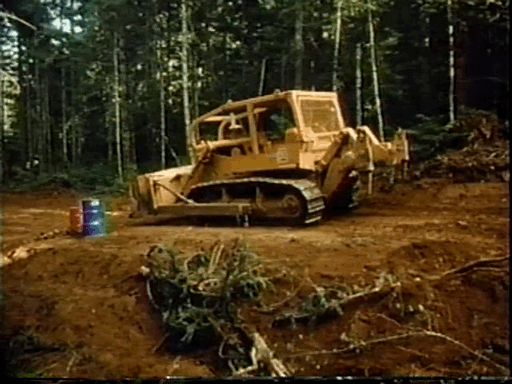 . We knew them only by their huge footprints in snow. In August 1958 around the lumber roads of Bluff Creek, California, north of Willow Creek, big footprints appeared at night. Each morning the lumber men came to their tractors, earth movers, and dozers only to find big barefoot footprints impressed all around in the chocolate colored mud. Two different types were found. One was a big fat enlarged human print. The other was a funny hourglass shaped print with a pointless groove in the ball of the foot.
. We knew them only by their huge footprints in snow. In August 1958 around the lumber roads of Bluff Creek, California, north of Willow Creek, big footprints appeared at night. Each morning the lumber men came to their tractors, earth movers, and dozers only to find big barefoot footprints impressed all around in the chocolate colored mud. Two different types were found. One was a big fat enlarged human print. The other was a funny hourglass shaped print with a pointless groove in the ball of the foot.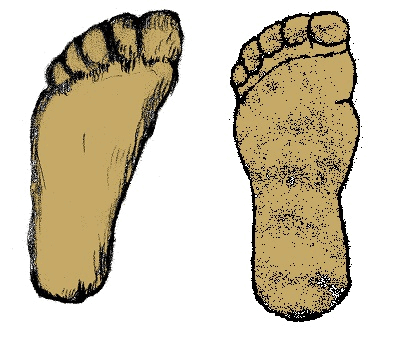
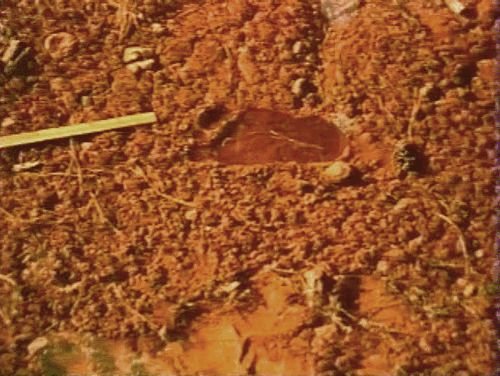 mysterious owner of the feet was declared to be BIG FOOT. That seemed accurate enough.
mysterious owner of the feet was declared to be BIG FOOT. That seemed accurate enough.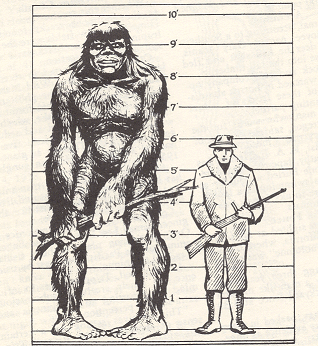
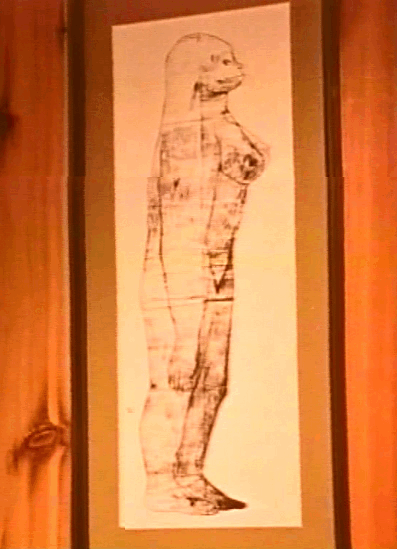
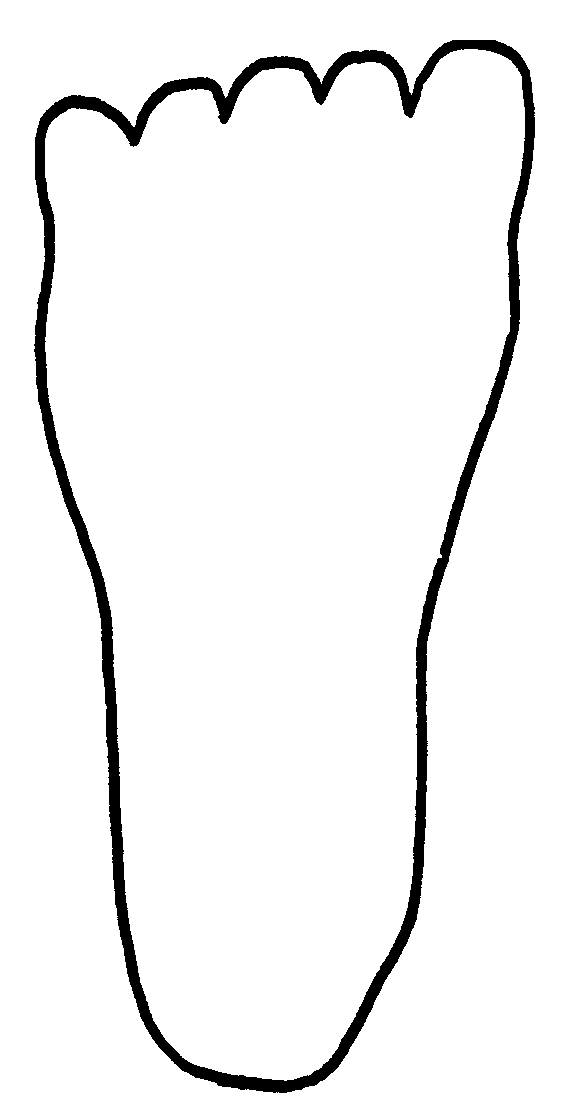
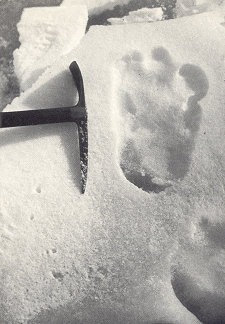 cast, in outline anyway, appeared almost identical to the Ruby Creek Sasquatch print Green had shown him.
cast, in outline anyway, appeared almost identical to the Ruby Creek Sasquatch print Green had shown him. 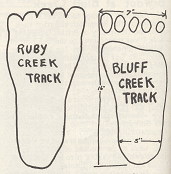
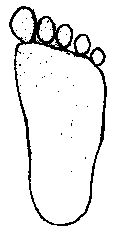
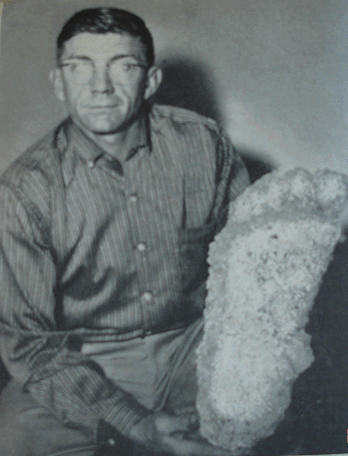 he had seen 9 years before. He would later declare these prints to be “typical” of the tracks of Bluff Creek.
he had seen 9 years before. He would later declare these prints to be “typical” of the tracks of Bluff Creek.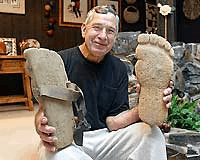 confession of the family was condemned by Bigfooters. Not only this, it was vehemently denied that Ray could have been responsible. Unfortunately for these arguments, Ray’s nephew Dale showed the wooden feet to the world. They matched the “hourglass” prints so common at Bluff Creek.
confession of the family was condemned by Bigfooters. Not only this, it was vehemently denied that Ray could have been responsible. Unfortunately for these arguments, Ray’s nephew Dale showed the wooden feet to the world. They matched the “hourglass” prints so common at Bluff Creek. 